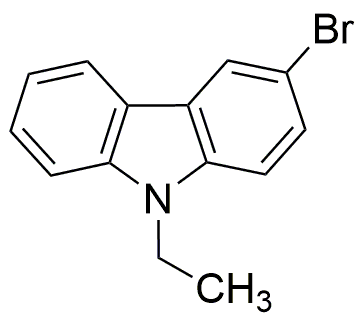3-Bromo-9-ethylcarbazole is widely utilized in research focused on:
- Organic Electronics: This compound is used in the development of organic light-emitting diodes (OLEDs), enhancing the efficiency and color purity of displays in consumer electronics.
- Pharmaceutical Research: It serves as an important intermediate in the synthesis of various pharmaceuticals, particularly in creating compounds that target specific biological pathways.
- Material Science: The chemical is explored for its properties in creating advanced materials, such as polymers with improved thermal stability and electrical conductivity.
- Photovoltaic Cells: It is being investigated for its potential in organic solar cells, contributing to renewable energy solutions with cost-effective production methods.
- Fluorescent Probes: This compound is utilized in the development of fluorescent markers for biological imaging, aiding researchers in visualizing cellular processes with high specificity.
Informations générales
Propriétés
Sécurité et réglementation
Applications
3-Bromo-9-ethylcarbazole is widely utilized in research focused on:
- Organic Electronics: This compound is used in the development of organic light-emitting diodes (OLEDs), enhancing the efficiency and color purity of displays in consumer electronics.
- Pharmaceutical Research: It serves as an important intermediate in the synthesis of various pharmaceuticals, particularly in creating compounds that target specific biological pathways.
- Material Science: The chemical is explored for its properties in creating advanced materials, such as polymers with improved thermal stability and electrical conductivity.
- Photovoltaic Cells: It is being investigated for its potential in organic solar cells, contributing to renewable energy solutions with cost-effective production methods.
- Fluorescent Probes: This compound is utilized in the development of fluorescent markers for biological imaging, aiding researchers in visualizing cellular processes with high specificity.
Documents
Fiches de données de sécurité (FDS)
La FDS fournit des informations de sécurité complètes sur la manipulation, le stockage et l’élimination du produit.
Spécifications du produit (PS)
Le PS fournit une description complète des propriétés du produit, notamment sa composition chimique, son état physique, sa pureté et les exigences de stockage. Il détaille également les plages de qualité acceptables et les applications prévues du produit.
Certificats d'analyse (COA)
Recherchez des certificats d'analyse (COA) en saisissant le numéro de lot du produit. Les numéros de lot et de lot se trouvent sur l'étiquette d'un produit, après les mots « Lot » ou « Lot de fabrication ».
Numéro de catalogue
Numéro de lot/série
Certificats d'origine (COO)
Ce certificat d'exploitation confirme le pays dans lequel le produit a été fabriqué, et détaille également les matériaux et composants utilisés et s'il est issu de sources naturelles, synthétiques ou autres sources spécifiques. Ce certificat peut être requis pour les douanes, le commerce et la conformité réglementaire.
Numéro de catalogue
Numéro de lot/série
Fiches de données de sécurité (FDS)
La FDS fournit des informations de sécurité complètes sur la manipulation, le stockage et l’élimination du produit.
DownloadSpécifications du produit (PS)
Le PS fournit une description complète des propriétés du produit, notamment sa composition chimique, son état physique, sa pureté et les exigences de stockage. Il détaille également les plages de qualité acceptables et les applications prévues du produit.
DownloadCertificats d'analyse (COA)
Recherchez des certificats d'analyse (COA) en saisissant le numéro de lot du produit. Les numéros de lot et de lot se trouvent sur l'étiquette d'un produit, après les mots « Lot » ou « Lot de fabrication ».
Numéro de catalogue
Numéro de lot/série
Certificats d'origine (COO)
Ce certificat d'exploitation confirme le pays dans lequel le produit a été fabriqué, et détaille également les matériaux et composants utilisés et s'il est issu de sources naturelles, synthétiques ou autres sources spécifiques. Ce certificat peut être requis pour les douanes, le commerce et la conformité réglementaire.


